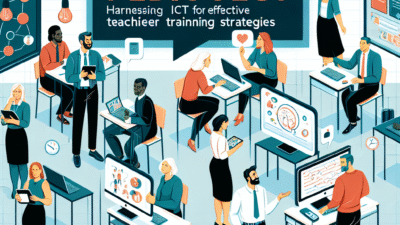Introduction
In an era where diversity is celebrated, the concept of inclusive education has emerged as a beacon of hope for many students. Yet, despite its importance, schools across the globe are grappling with the question: Inclusive Education: Why Are Schools Struggling to Make It Work? This article delves deep into the challenges and barriers that hinder the effective implementation of inclusive education, while also exploring actionable strategies to overcome these obstacles.
Inclusive education is not just a buzzword; it is a fundamental right for every child. It aims to provide equitable access to quality education for all students, regardless of their backgrounds or abilities. However, the journey toward achieving this ideal is fraught with complexities. In this comprehensive guide, we will explore the various dimensions of inclusive education, the reasons behind the struggles faced by schools, and practical solutions to foster a more inclusive environment.
Understanding Inclusive Education
What is Inclusive Education?
Inclusive education refers to an educational philosophy that advocates for the inclusion of all students in mainstream classrooms, regardless of their physical, intellectual, social, or emotional challenges. It emphasizes the need for schools to adapt their teaching methods, curricula, and environments to accommodate diverse learners.
The Importance of Inclusive Education
- Equity and Access: Inclusive education ensures that every child has the right to learn in an environment that respects their individuality.
- Social Integration: It fosters a sense of belonging and community among students, promoting social skills and empathy.
- Improved Academic Outcomes: Research shows that inclusive classrooms can lead to better academic performance for all students, not just those with disabilities.
The Struggles of Implementing Inclusive Education
1. Lack of Training and Resources
One of the primary reasons schools struggle with inclusive education is the lack of adequate training for teachers. Many educators are not equipped with the necessary skills to address the diverse needs of their students. This gap in training can lead to frustration and ineffective teaching practices.
Actionable Takeaway:
- Professional Development: Schools should invest in ongoing professional development programs focused on inclusive teaching strategies. Workshops, seminars, and online courses can provide teachers with the tools they need to succeed.
2. Insufficient Funding
Funding is a critical factor in the successful implementation of inclusive education. Many schools operate on tight budgets, making it challenging to allocate resources for specialized programs, materials, and support staff.
Actionable Takeaway:
- Advocacy for Funding: Educators and parents can advocate for increased funding at local, state, and federal levels. Collaborating with community organizations can also help secure additional resources.
3. Resistance to Change
Cultural and institutional resistance can hinder the adoption of inclusive practices. Some educators may hold biases or misconceptions about students with disabilities, leading to a reluctance to embrace inclusive education.
Actionable Takeaway:
- Awareness Campaigns: Schools can implement awareness campaigns to educate staff, students, and parents about the benefits of inclusive education. Sharing success stories and testimonials can help shift mindsets.
4. Inadequate Support Systems
For inclusive education to thrive, schools must establish robust support systems. This includes access to special education professionals, counselors, and paraprofessionals who can assist in the classroom.
Actionable Takeaway:
- Building Support Networks: Schools should create a network of support that includes special education teachers, therapists, and community resources. Regular collaboration among these professionals can enhance the learning experience for all students.
5. Curriculum Limitations
Traditional curricula often do not accommodate the diverse learning styles and needs of all students. Rigid structures can leave some students behind, making it difficult to achieve true inclusivity.
Actionable Takeaway:
- Curriculum Adaptation: Schools should consider adopting flexible curricula that allow for differentiation. This can include project-based learning, technology integration, and personalized learning plans.
Strategies for Successful Inclusive Education
1. Collaborative Teaching Models
Implementing collaborative teaching models can significantly enhance the effectiveness of inclusive education. Co-teaching, where general and special education teachers work together, allows for a more tailored approach to instruction.
2. Universal Design for Learning (UDL)
UDL is an educational framework that promotes flexible learning environments to accommodate individual learning differences. By incorporating multiple means of engagement, representation, and action, UDL can help create a more inclusive classroom.
3. Family and Community Engagement
Engaging families and the community in the educational process is vital for fostering an inclusive environment. Schools should encourage open communication and collaboration with parents to better understand their children’s needs.
4. Use of Technology
Technology can play a transformative role in inclusive education. Assistive technologies, such as speech-to-text software and interactive learning tools, can help bridge the gap for students with disabilities.
5. Continuous Assessment and Feedback
Regular assessment and feedback are essential for monitoring student progress and making necessary adjustments to teaching strategies. Schools should implement formative assessments that allow for ongoing evaluation of student learning.
Conclusion
The journey toward inclusive education is undoubtedly challenging, but it is also incredibly rewarding. By understanding the barriers that schools face and implementing effective strategies, we can create an educational landscape where every student feels valued and empowered.
As we reflect on the question Inclusive Education: Why Are Schools Struggling to Make It Work?, it becomes clear that the path forward requires commitment, collaboration, and a willingness to adapt. Together, we can build a brighter future for all learners.
FAQs
1. What is the main goal of inclusive education?
The main goal of inclusive education is to provide equitable access to quality education for all students, regardless of their abilities or backgrounds.
2. How can teachers be better prepared for inclusive classrooms?
Teachers can be better prepared through professional development programs focused on inclusive teaching strategies, collaboration with special education professionals, and ongoing training.
3. What role do parents play in inclusive education?
Parents play a crucial role by advocating for their children’s needs, collaborating with teachers, and participating in school activities to foster a supportive environment.
4. How can technology support inclusive education?
Technology can support inclusive education by providing assistive tools that cater to diverse learning needs, such as speech recognition software and interactive learning platforms.
5. What are some common misconceptions about inclusive education?
Common misconceptions include the belief that inclusive education lowers academic standards or that it is only for students with disabilities. In reality, inclusive education benefits all students by promoting diversity and collaboration.
By addressing the challenges and implementing effective strategies, we can pave the way for a more inclusive educational system that benefits everyone. Let’s work together to ensure that every child has the opportunity to thrive in a supportive and inclusive environment. 🌟





